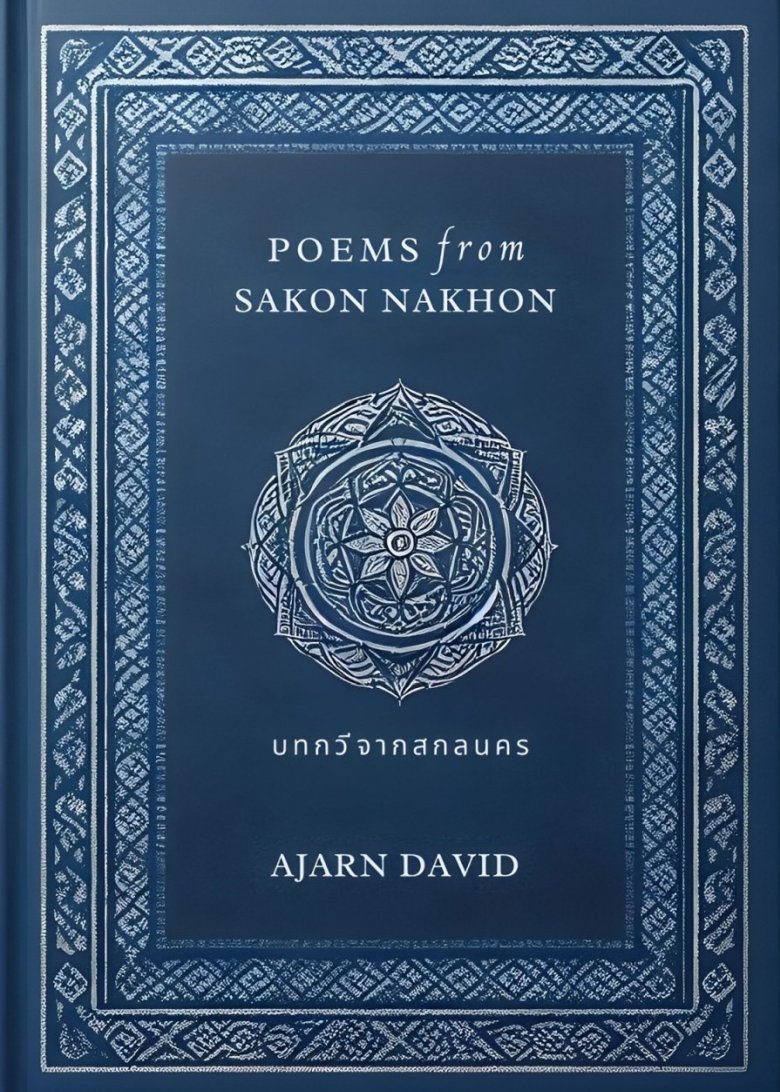"Poems from Sakon Nakhon is as much a cultural resource as it is a "Learn Thai" language tool. By engaging with the poems, learners gain insights into Thai customs, values, and perspectives."
Using Poetry to Learn Thai
F
or anyone interested in learning Thai, Ajarn David’s Poems from Sakon Nakhon offers a unique and creative tool. This bilingual poetry collection pairs 91 English poems with Thai translations and phonetic transliterations, creating an immersive learning experience that goes beyond conventional "Learn Thai" language textbooks.
By blending culture, language, and art, this book of poetry provides a compelling way for foreigners to deepen their understanding of both the Thai language and the culture it embodies.
Thai Transliteration: A Practical Learning Tool
E
ach poem is presented in three forms: the English original, the Thai translation, and the transliteration of the Thai text into Roman characters with tone markers. For beginners, this structure is particularly helpful. Learners can use the English as a guide to understand the meaning of the Thai text while practicing the pronunciation provided in the transliteration.
For example, a poem about the first Noble Truth of Buddhism (All Life is Suffering) includes the transliterated line:
sàt-jà pút-tá kâw ráek chee-wít túk săen bprae
By referencing both the transliteration and the Thai script (สัจจะพุทธะข้อแรก ชีวิตทุกข์แสนแปร), learners can start associating the sounds of the Thai language with its written form, an essential step for fluency.
Methods for Using the Book to Learn Thai
H
ere are some practical ways learners can use Poems from Sakon Nakhon to improve their Thai:
Read Aloud with Phonetics
Begin by reading the transliterated lines aloud, focusing on rhythm and tone. Thai is a tonal language, and the natural musicality of the poems makes it easier to internalize the tones through repeated practice.
Compare and Contrast
Compare the English original with the Thai translation of the poem. Identify common words and phrases in Thai and their English counterparts. This method helps build vocabulary while providing cultural context.
Also note how the translated Thai poem differs from the English, due to the nuances of the Thai language and the sensibilities of Thai culture. Use Google Translate to understand the literal translation of the Thai poetry.
Practice Writing Thai Script
Use the Thai version of the poems as a model to practice writing. Copying out the poems reinforces familiarity with Thai script and improves writing fluency.
Listen and Recite
Record yourself reading the transliterated text and compare it with native Thai speakers or language apps. Recitation is particularly effective for memorizing common sentence structures and idiomatic expressions.
Try speaking your recitation into Google Translate to see if it correctly understands your pronunciation.
Learn Thai Culture Through Language
Pay attention to cultural concepts embedded in the language, such as greng-jai (consideration for others) and mai pen rai (a philosophy of letting go). Understanding these cultural elements enhances comprehension and conversational fluency.
Learn Vocabulary Through Thai Poetry
Ajarn David’s poems provide a rich vocabulary drawn from everyday life, nature, and spirituality. Words like máai (ไม้, tree), nám (น้ำ, water), and sà-wăn (สวรรค์, heaven) recur across the collection, making them easy to remember. The imagery of the poems also gives learners visual anchors for new words.
For instance, in a poem about Thailand:
เมืองไทยสอนบทเรียน... จากชีวิตที่ผ่าน
(Meuang tai săwn bòt rian ... jàak chee-wít têe pàan )
Thailand teaches lessons… from life as it is lived.
This simple yet profound line not only teaches vocabulary like săwn (teach) and chee-wít (life) but also conveys cultural wisdom.
Immersion in Thai Culture
T he book is as much a cultural resource as it is a "Learn Thai" language tool. By engaging with the poems, learners gain insights into Thai customs, values, and perspectives. For instance, a poem about being "greng jai" explains the essence of Thai social interactions, while a poem about the rainy season illustrates how closely Thai life is tied to nature:
ความรักผลิบานไม่คาดฝัน ดุจสายฝนกลางแดดของวันอันแจ่มใส
kwaam-rák plì baan mâi-kâat-făn · dùt săai-fŏn glaang dàet kăwng wan an jàem-săi
Love blossoms unexpectedly... like rain on a sunny day.
For Thai Learners of All Levels
W
hether you are just starting your Thai language journey or looking to refine your skills, Poems from Sakon Nakhon offers resources for every level:
Beginners will appreciate the transliterations and straightforward English translations, which make the Thai poems accessible.
Intermediate learners can challenge themselves by focusing on the Thai script and identifying key grammar patterns.
Advanced learners can delve deeper into the nuances of Thai idioms and language structures, gaining a deeper understanding of literary Thai.
A Thai Language Resource with Heart
B
eyond its utility as a Thai learning tool, Poems from Sakon Nakhon is a heartfelt exploration of Thailand’s people, landscapes, and values. For language learners, this means every word is steeped in cultural meaning, making the act of learning not just practical but deeply rewarding.
If you’re looking for a way to engage with the Thai language that goes beyond vocabulary lists and grammar exercises, this book is an ideal choice. It offers an experience that is as poetic as it is practical, turning language learning into a journey of cultural discovery.
With Poems from Sakon Nakhon, Ajarn David has given learners a bridge into Thai life, language, and soul—a gift that will resonate with readers for years to come.





